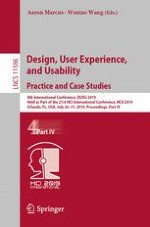2019 | OriginalPaper | Chapter
Using Mobile Eye Tracking to Evaluate the Satisfaction with Service Office
Authors : Zai Xing Liu, Yi Liu, Xun Gao
Published in: Design, User Experience, and Usability. Practice and Case Studies
Publisher: Springer International Publishing
Activate our intelligent search to find suitable subject content or patents.
Select sections of text to find matching patents with Artificial Intelligence. powered by
Select sections of text to find additional relevant content using AI-assisted search. powered by
